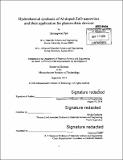Hydrothermal synthesis of Al-doped ZnO nanowires and their application for photovoltaic devices
Author(s)
Park, Hyoungwon
DownloadFull printable version (9.563Mb)
Other Contributors
Massachusetts Institute of Technology. Department of Materials Science and Engineering.
Advisor
Silvija Gradec̆ak.
Terms of use
Metadata
Show full item recordAbstract
Semiconductor nanostructures exhibit distinct properties by virtue of nano-scale dimensionality, resulting in recent interest in semiconducting nanowires for electronic, photonic, and energy applications. Along with nanowires, quantum dots are solution-processable nanocrystals with tunable band gap energies as a function of their size. Based on all of these promising properties that nanostructures exhibit, nanowires and quantum dots are excellent candidates for next-generation optoelectronic devices, including solar cells and light-emitting diodes. However, the realization of nanostructured materials for solar cell device applications is limited by the fundamental trade-off between light absorption and photocarrier collection. Vertically aligned ZnO nanowire arrays can decouple absorption and collection by acting as highly-conductive channels for extracting photogenerated electrons from deep within the film. This thesis illustrates a scheme for the development of ordered bulk heterojunction photovoltaic devices incorporating solution-based n-type doped ZnO nanowires and PbS quantum dots. In order to improve the electrical properties of ZnO nanowires, Al doping of hydrothermally synthesized ZnO nanowires is studied along with the optimization of doping concentration. The morphology of ZnO nanowire arrays is also studied as a function of the doping concentration in the growth solution. Finally, photovoltaic devices are fabricated and the effect of Al-doping of ZnO nanowires is investigated by device characterization techniques.
Description
Thesis: S.M., Massachusetts Institute of Technology, Department of Materials Science and Engineering, 2014. Cataloged from PDF version of thesis. Includes bibliographical references (pages 55-61).
Date issued
2014Department
Massachusetts Institute of Technology. Department of Materials Science and EngineeringPublisher
Massachusetts Institute of Technology
Keywords
Materials Science and Engineering.